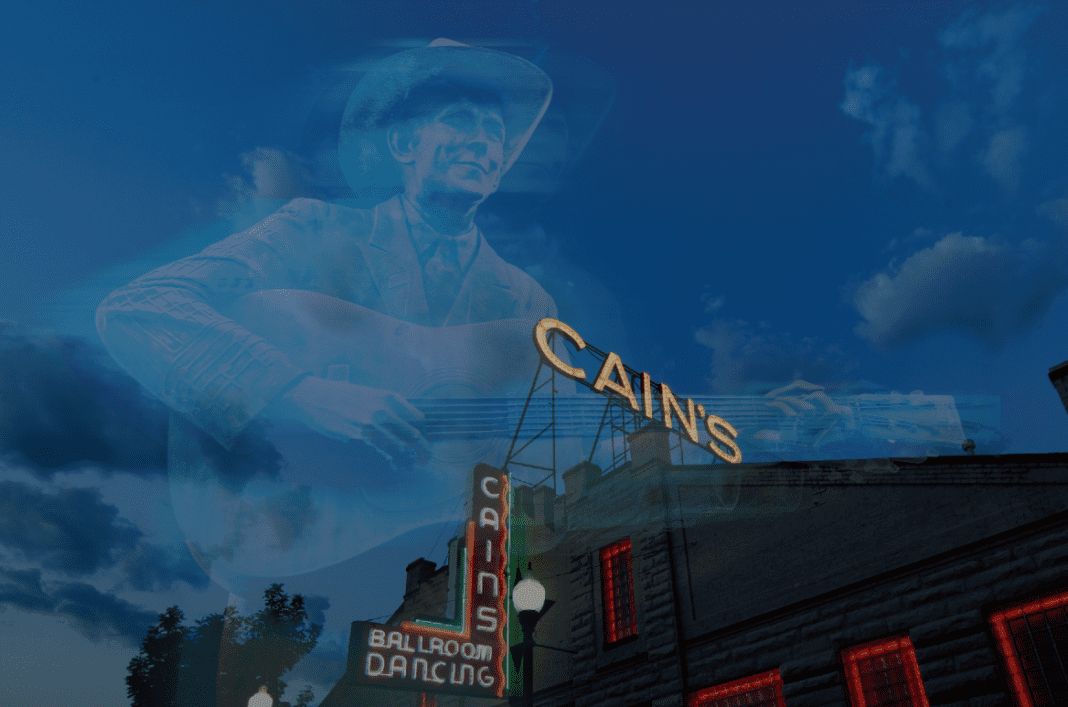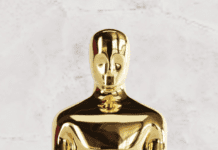As Brett Bingham and I noted in our recent book, Twentieth-Century Honky-Tonk, what might be termed the “modern era” of Tulsa’s Cain’s Ballroom began 48 years ago this month, when a pair of young Tulsa promoters – R.C. Bradley and Jim Edwards – talked the owner into letting them book a Halloween show featuring neither Western-swing nor country-music acts. For nearly 50 years, those two musical genres had been the ballroom’s bread and butter, beginning in 1935, when Western-swing pioneer Bob Wills made the Cain’s his base of operations.
Bradley and Edwards, however, on Halloween night 1974, booked a slate of acts ranging from country-rock to R&B, breaking with tradition and starting a run of Oct. 31 events that helped change the image of the ballroom from country to, well, hippie, attracting a whole new demographic in the bargain.
So Halloween figures strongly into the history of the Cain’s Ballroom. And what’s Halloween without ghosts?
There are, of course, the metaphorical ghosts of yesterday, the fading echoes of a vanished time, the ghostly flickers of familiar faces, brought back to life whenever old-timers congregate again at the Cain’s and find themselves facing the younger spirts of their former selves. But evidence exists to suggest that there are literal ghosts haunting the venerable ballroom as well.
David Standingwater, a longtime Cain’s bartender, figures he first saw what his bar manager David Ward calls the Phantom Cowboy back around 2006 or 2007, after he’d been working at the bar for a few years.
“Before I became a bartender, David hired me to be the bar-back, so I would help set up the bars and make sure everything was stocked,” says Standingwater. “In those days, it took a lot more to get the bar ready, because we weren’t as advanced as we are now, so I’d sometimes come in the night before. It’d be me, by myself, and the ballroom would be all dark except for the bar area. The room creaks, so I’d hear little noises here and there.
“To set up, I’d have to be in and out of the walkway at the main bar. There’s a little hallway between the walk-in and the bathroom, and there’s a pillar in the middle of the bar that kind of coincides with the hallway. So, when I was coming out of the walk-in and into the hallway, that pillar would be in my line of sight. And on two or three particular nights, as I was going in and out – all of a sudden, from the corner of my eye, in my peripheral vision, I saw a cowboy, leaning against the bar.”
Standingwater adds that the figure seemed to be waiting for something – “maybe for me to get done, so that I could serve him,” he guesses – but when he focused on the figure, it evaporated into the surrounding darkness.
“I guess ‘silhouette’ would be the best description of what I saw,” he says, “but I can remember that he was in a jacket, and he had a hat on. It reminded me of the picture of Hank Williams Sr. that’s on the [Cain’s] wall – kind of that slender, jacketed cowboy.”
He figures he spied the apparition two or three times, all within the space of a couple of nights. And he feels that there’s reason to believe it could be the spirit of Hank Williams himself, whose complicated and ultimately tragic life has given rise to any number of ghostly legends. (Listen, for instance, to the 1983 hit country single “The Ride,” by former Cain’s habitue David Allan Coe.)
“There’s a red couch with the Cain’s embroidery on it that’s in the [Cain’s] office now,” says Standingwater.
“Before we had the bar area upstairs and opened [the balcony] to the public, the couch was being stored up there – and it’s rumored that Hank Sr. actually fell asleep on that couch a long time ago.”
That rumor is likely true, as the one time Hank Williams was booked into the Cain’s he showed up but was unable to perform for any length of time … reportedly due to his overconsumption of Choc beer from down the street.
Maybe, he stuck around.
The upstairs renovation Standingwater mentioned began around 2006, when Cain’s management decided to put a bar and rest room in the ballroom’s former attic and open the area to patrons. The work done to transform the space included tiling, which was contracted.
“There was a young man who was doing the tile, and one day he ran down to the office and told Chad [Rodgers, Cain’s co-owner] that there was a ‘phantom cowboy’ upstairs,” notes David Ward. “That guy wouldn’t come back. They had to send someone else to finish the tile.”
Like Standingwater, David Ward has experienced things in the Cain’s Ballroom that defy logic. And he and his former bar-back are hardly alone. Several years ago, the Paranormal Investigation Team of Tulsa, or PITT, spent a night in the ballroom, setting up equipment in hopes of recording something otherworldly. PITT sent over a computer file of the results, and during a show, Ward and ballroom co-owner Hunter Rodgers listened to it on the Cain’s office computer.
“I didn’t hear a thing,” Ward remembers. “I came out and had a couple of the bar staff listen, and they couldn’t really hear anything either.”
A couple of weeks later, he decided to try again. He put the file on his thumb drive and, when he was through for the night, took it home with him. In the very early morning quiet, with just him and his computer and the file, he heard a distinct voice – that of a child.
“It said ‘I wanna help,’” he notes, “and the hair stood up on the back of my neck.”
Returning to the Cain’s, he brought in his home computer and played the recording for two of his staff members. They not only heard the voice as well; they also told Ward they were familiar with it. It would always, they said, come from the northwest corner of the ballroom.
After the initial excitement of hearing and sharing the spectral words, and having his staffers tell him that they recognized them, Ward didn’t give the recording much more thought. That changed one evening while he was working a private event at the Cain’s. There, he heard a lecturer explain that, during Bob Wills’ days at the ballroom, parents would sometimes bring in cots and blankets, set them out beside the walls, and leave their kids there, to play with other children and eventually fall asleep. One of the parts of the ballroom used for this purpose, the speaker said, was the northwest corner.
“I knew, when I heard that story, my ghost was real,” says Ward. “That’s why there was a child there.”
He adds that the PITT people told him ghosts like that one are “residual.”
“Whatever they are, they’re leftovers,” he explains, “and they have some connection to the room. Sometimes that connection is positive, and sometimes that connection is negative. What I think is this: Citizens in Tulsa and Oklahoma have been coming into that room for a long time, and as it approaches 100 years, it’s probably hosted a ghost or two.”
“I’m not necessarily sold on the ghost thing,” admits Standingwater. “But, you know, I believe in something. If you think about my ancestry, the Native Americans, we have all the stories of what are called skill’li in the Cherokee language – the little people who roam around in the woods and lead children astray. So I guess it’s in my nature. I believe something’s going on out there. I’m just not sure exactly what it is.”


























